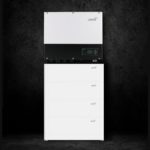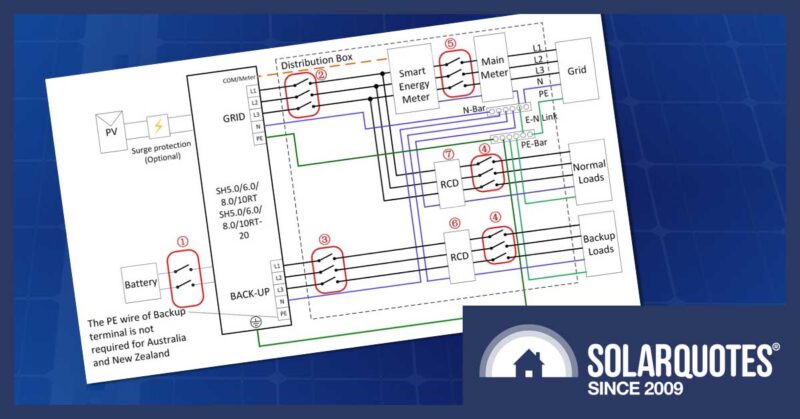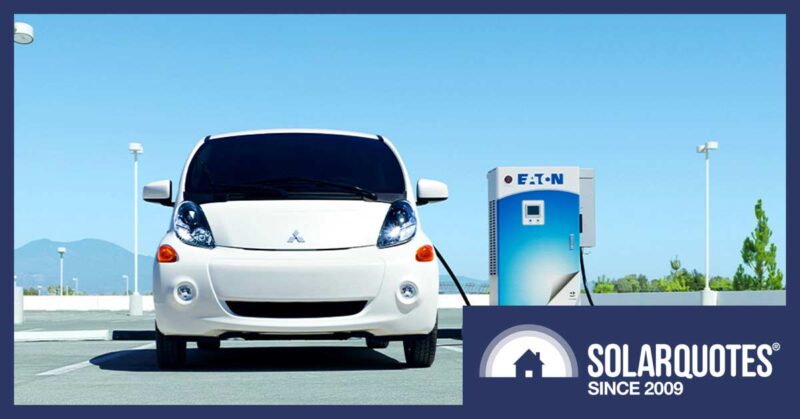Battery Degradation: How Do You Work Out If Your Battery Is Up To Snuff?
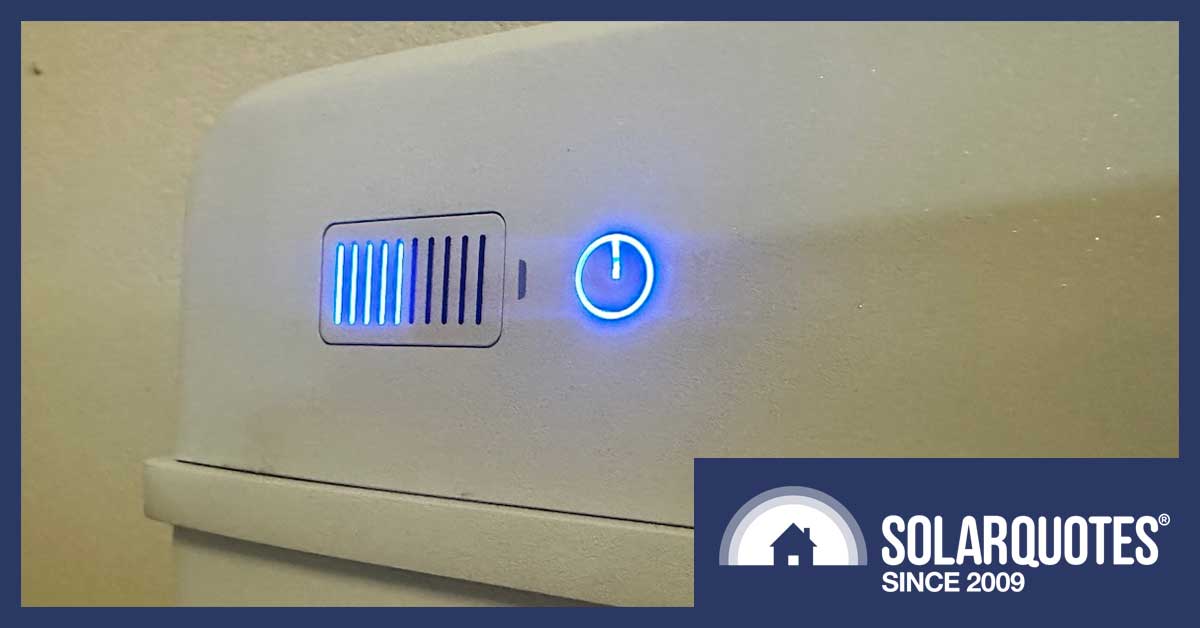
In this first of a two-part series, we’re going to shed light on some of the lurks you need to know about owning a battery hybrid solar power system. Specifically understanding, measuring and managing the degradation.
Which Battery Specifications Degrade?
- Firstly there’s the rated capacity in kilowatt hours (kWh). This refers to the volume of energy your battery can hold. Unlike a water tank, your battery’s capacity will effectively shrink over time. Warranties typically account for this saying they’ll deliver perhaps 60% of the rated capacity after a decade in service*
(the asterisk refers to special conditions in the fine print, which is where the grief begins)]
- Secondly, there’s the surge capacity or C rating, which is essentially how much energy the battery can deliver all at once. This factor is often overshadowed by the inverter’s peak capacity in kilowatts (kW). Imagine this as the size of the hose coming from the tank. When you open the tap, water can gush out, but it also needs some head pressure to drive it at more than a dribble. You’ll encounter this with some hybrids that use modular batteries because they need 3 cell blocks for basic functionality, but full headline output needs 5 cell blocks in the battery, which can go on to be 9 in a stack. It’s a bit like comparing a tank to a water tower.
Understanding Battery Degradation: How Will You Know?
As the battery ages, you’ll probably not notice your grid-connected battery doesn’t quite deliver the punch it once did. There are a few reasons, but they stem from the fact that lithium batteries are managed by a layer of electronics (a BMS) to ensure they’re kept in the Goldilocks zone of temperature and charge.
For instance, you can hear when the starting battery in your car is under peak load cranking the engine. When it’s old, sick or just flat, then it’s obvious you need a jump start.
Whereas your house battery system, when trying to crank up the fridge, has a permanent jumper cable connected to the main grid. If the battery doesn’t deliver the required grunt, the grid steps in, and this is why cheap rubbish hybrid systems get away with poor surge ratings; they rely heavily on big brother to help out.
If you keep an eye on the monitoring, you will notice the amount of energy the battery will store overall. Say it’s 10kWh; when new you may see it reaches 100% state of charge at 12pm. Then at sundown, you get 5 hours of use at a steady 2kW discharge running the air conditioning. Ten years later, it takes less time to fill, and you’ll find it only lasts for 3 hours in the evening.
It’s worth sizing your battery with this in mind.
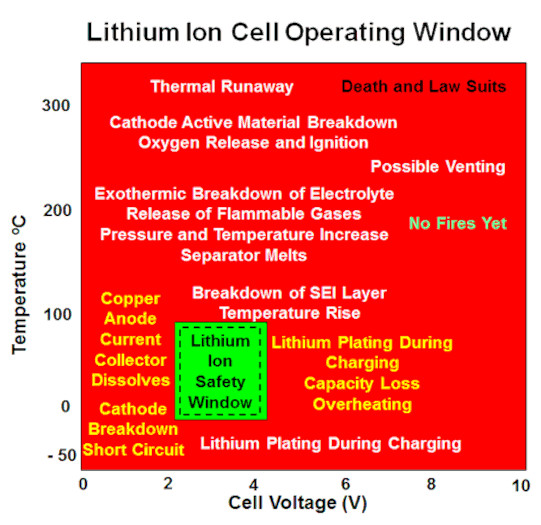
The battery management system (BMS) monitors temperature, manages voltage and limits current, keeping your lithium cells in a comfortable window. Image credit www.mpoweruk.com
What Shortens Battery Life?
Temperature. It’s that simple.
Anything electrical creates heat in operation, batteries in particular, because of the chemical action inside them. In Australia, keeping your battery cool is a no-brainer. The best battery enclosure I ever saw was a concrete bunker under a garage, a wine cellar for electricity storage, if you will.
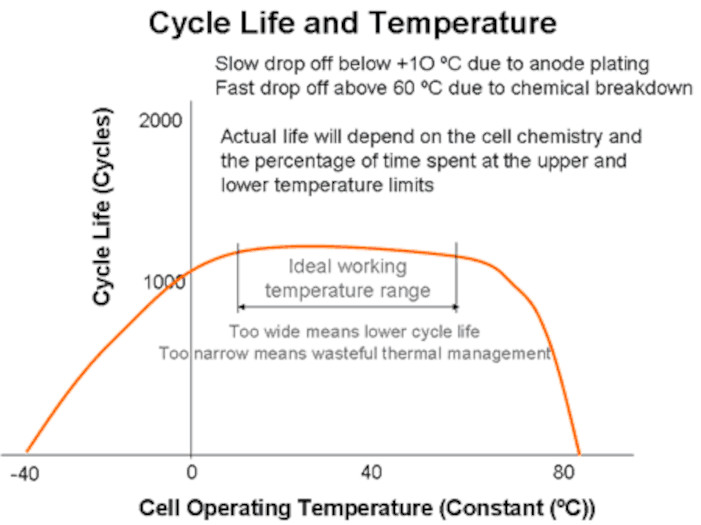
You need not add any ambient temperature from a hot summer’s day in Australia, but a Canberra winter might not help either. Image credit www.mpoweruk.com
Bear in mind batteries have both a cycle life and a shelf life. Leaving them on a shelf is one of the worst things you can do. Lithium chemistries are pretty durable (while Nickel Iron NiFe will outlast Keith Richards,) but for a lead acid battery, discharging it and leaving the battery stand will ruin it in a few weeks flat. Pun intended.
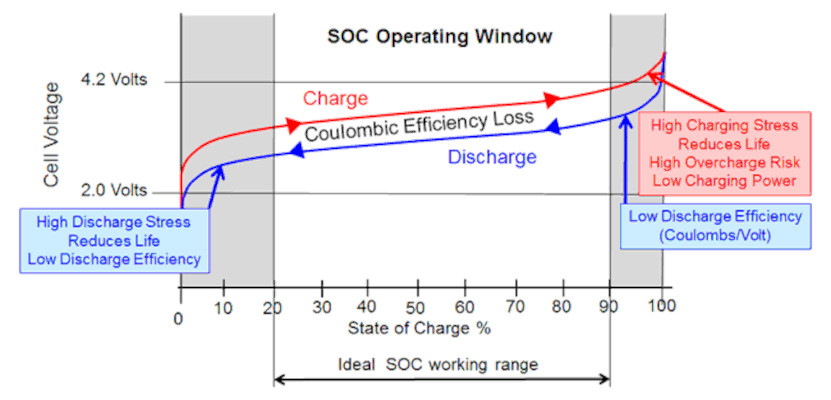
20% – 90% is where lithium cells work best, but what you’ll find is engineers design their BMS to avoid the extremes shown here. The user interface might display “FULL” at 80% and “FLAT” 30% and as the battery ages, the management might also extend the range used to mask degradation. image credit www.mpoweruk.com
The Impact of Battery Size on Long-Term Performance
The importance of correct battery sizing cannot be overstated.
You, the customer, need to know how much you want. Something modest to keep the lights and fridge going overnight? Or something ludicrous if you’re going to run the air conditioning and trade on the electricity spot market.
Deep depths of discharge should be avoided if possible, if only because some warranties are rendered void if you work the batteries too hard.
When you buy a modern, high-voltage hybrid package, the factory makes complex engineering decisions about chemistry, size & BMS to give you performance that meets its kilowatt-hour sticker rating. In contrast, a traditional off-grid system will be specified by the system designer that does the installation, so you might get to see “under the bonnet” in terms of cells, voltages, C rates and amp-hour ratings.
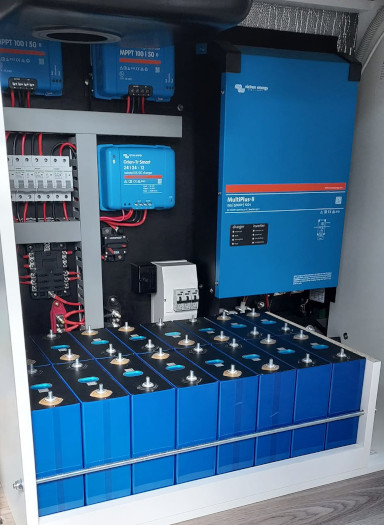
Not under the bonnet but under the sink. This unfinished caravan power system shows an open bank of individual 3.7volt prismatic cells. It’s nicely done but unlikely to be compliant.
How conservative are the battery specifications?
When Harley Davidson released their first ever electric motorcyle;
- They specified a 15kWh battery and gave it range and warranty ratings to suit.
- Owners have been really pleased with it’s durability, they’re not losing range or performance.
- A fairly sensible rumour has it that this machine runs a 20kWh pack and it’s just being very conservatively managed by the BMS as a 75% smaller unit.
It makes perfect sense that an expensive legacy brand, entering its first product into a new market, wants to ensure it doesn’t become a disaster, so they’ve built in a 25% safety margin. As a domestic battery customer, you need to weigh up how conservative you think the engineers are when specifying your battery.
It’s an impossible task, but really, the only way to judge is;
- What warranty are they offering
- For how much performance
- At a given price.
- And, of course, will they be around to honour the warranty?
Suppose you are offered a cheap home battery with a crappy warranty compared to others on the market. In that case, you are likely getting less battery than other products with the same official specification. Battery warranties matter. Read them.
So How Can We Weigh Up, Gauge Depth and Measure It?
In our next instalment, I’ll explain what you need to keep an eye on, how warranties are specified, how they test for performance if you raise some concern and how they’ll try to use a few disheartening tricks to deny your claim.
Original Source: https://www.solarquotes.com.au/blog/battery-degradation-solar-power-system/







